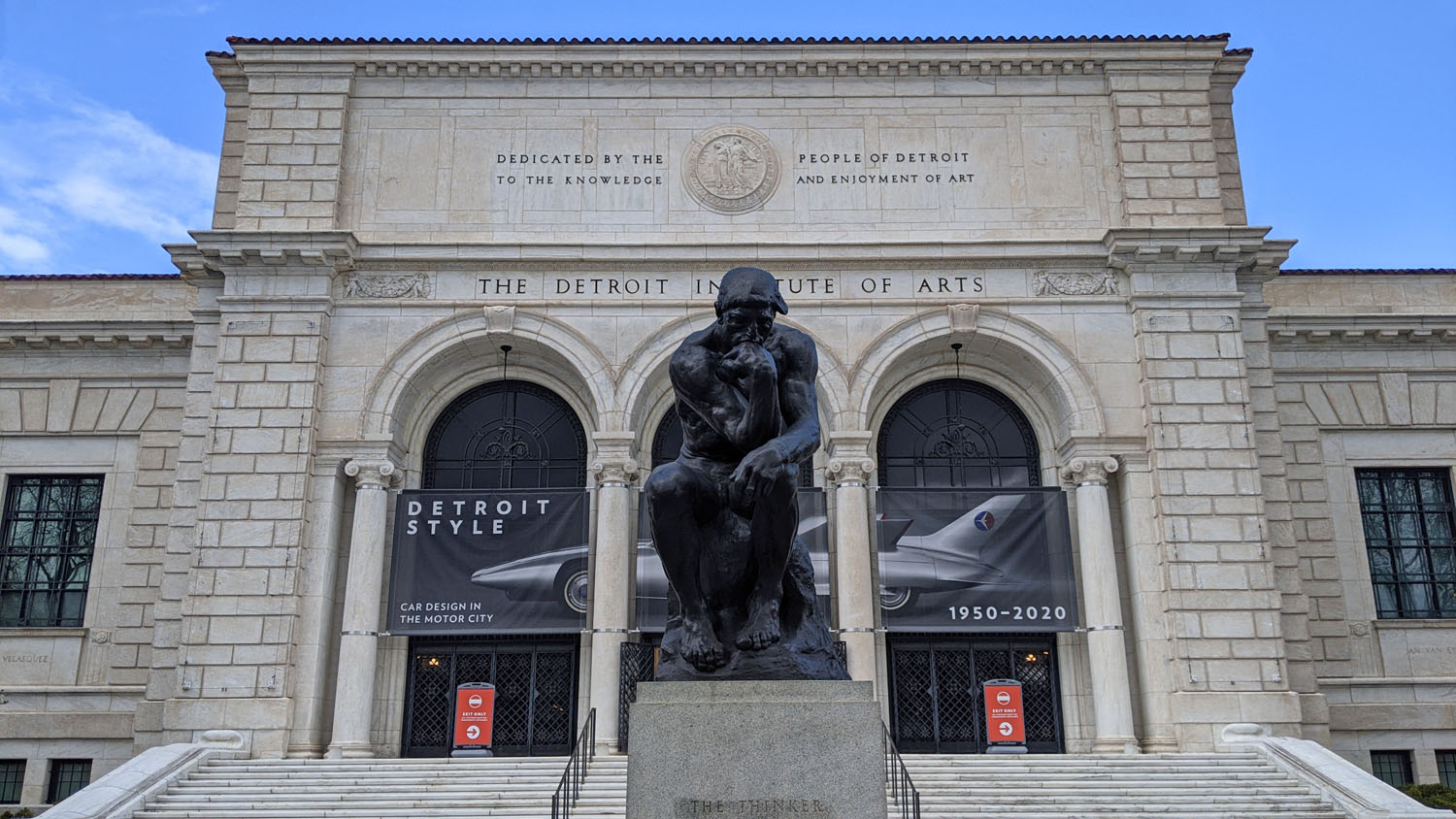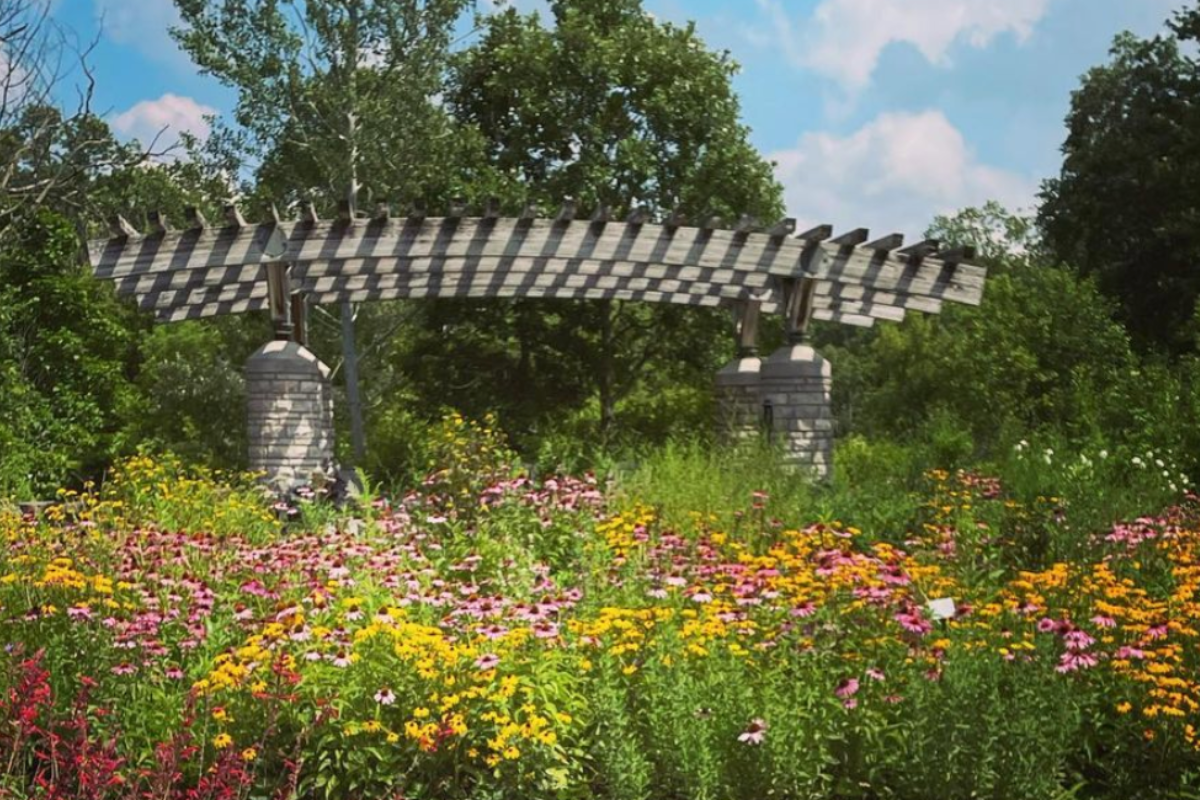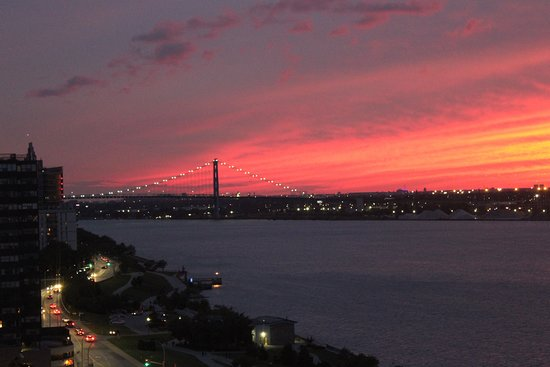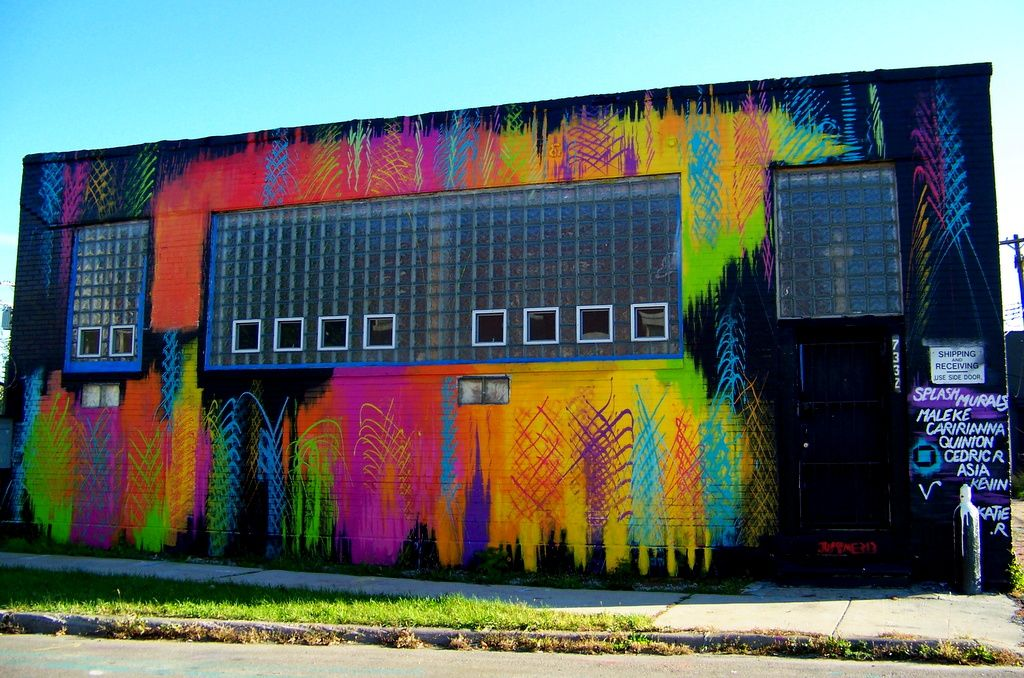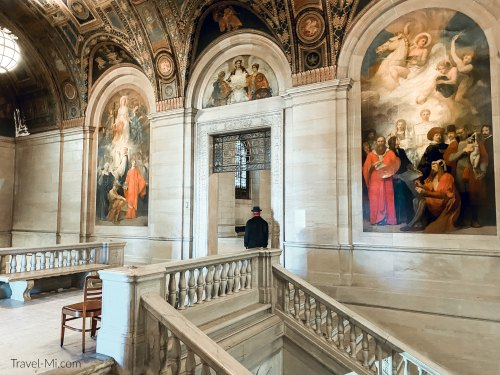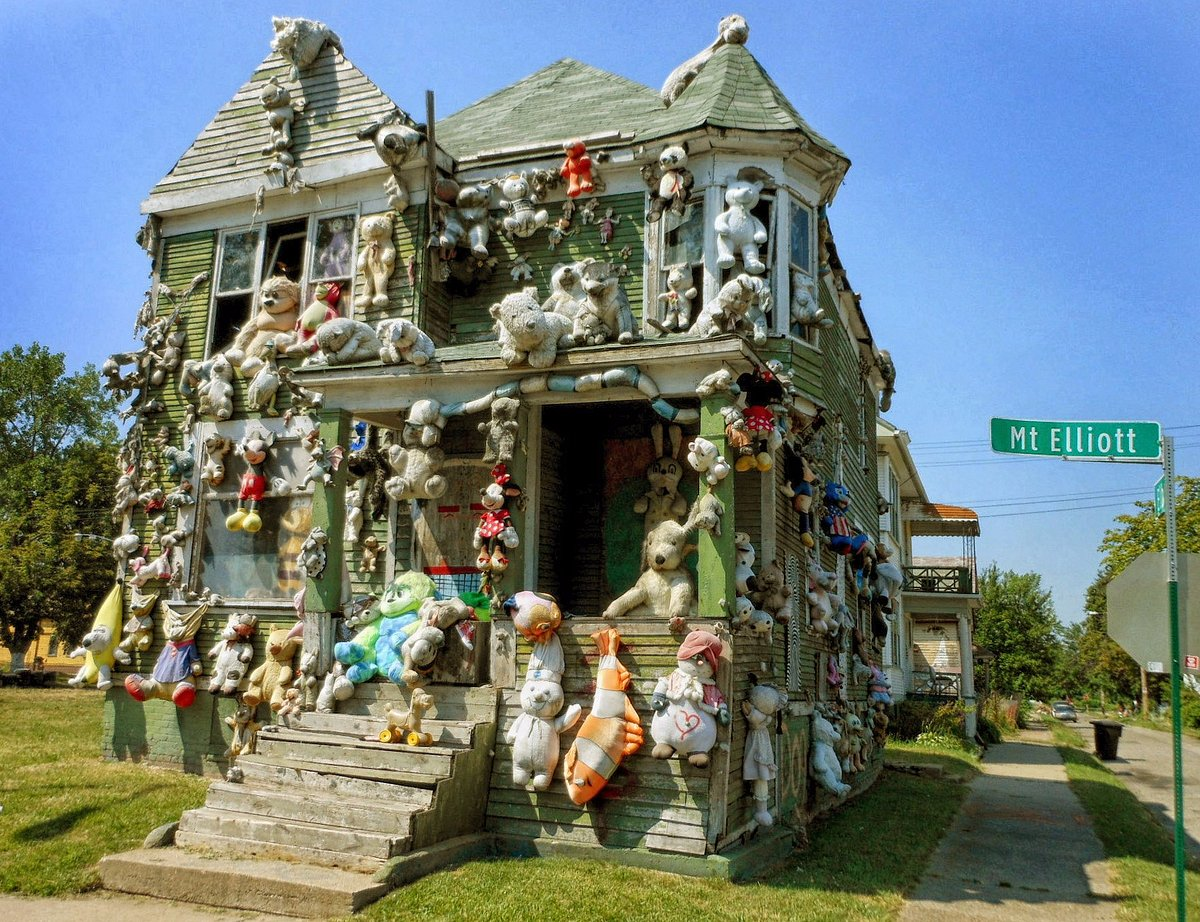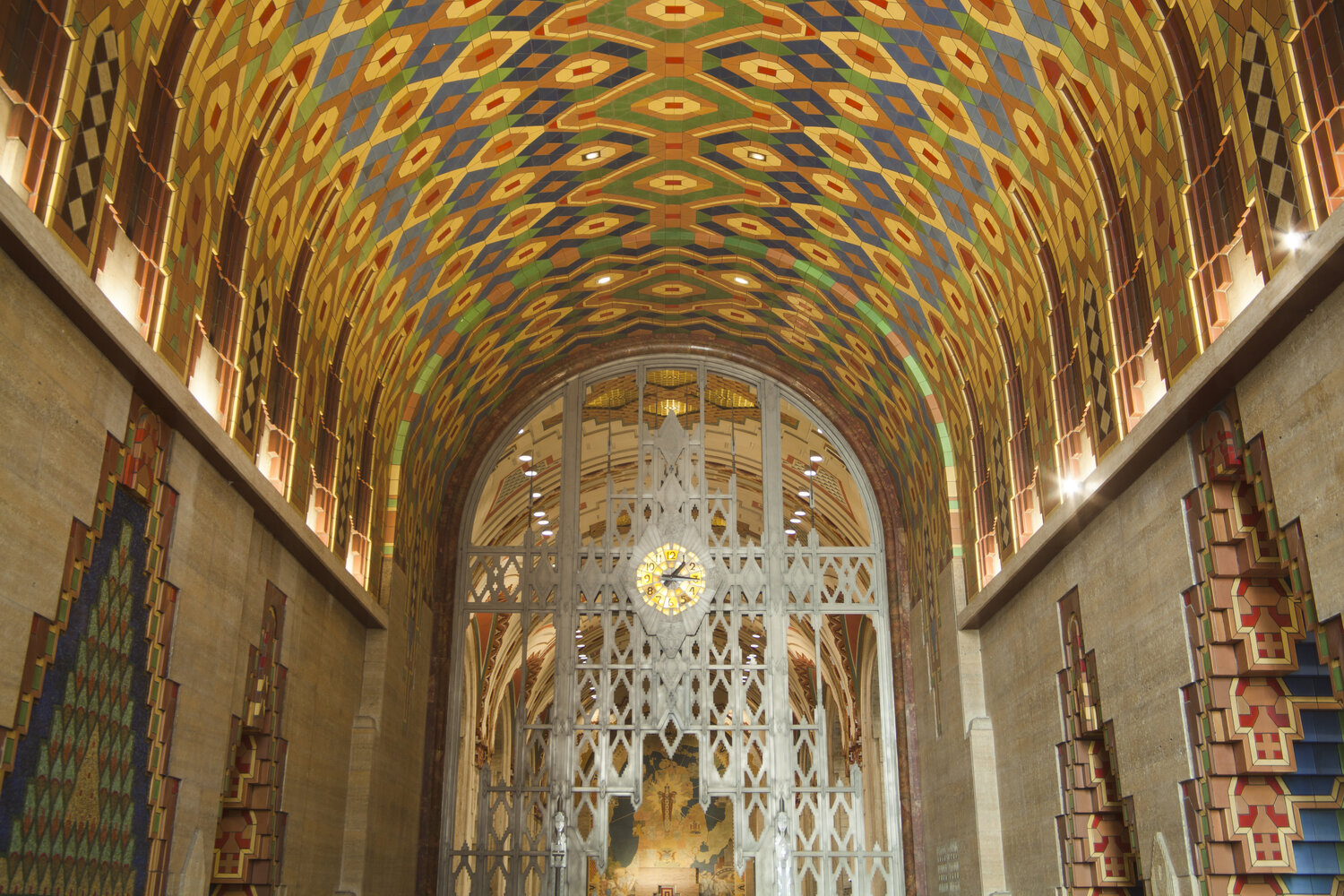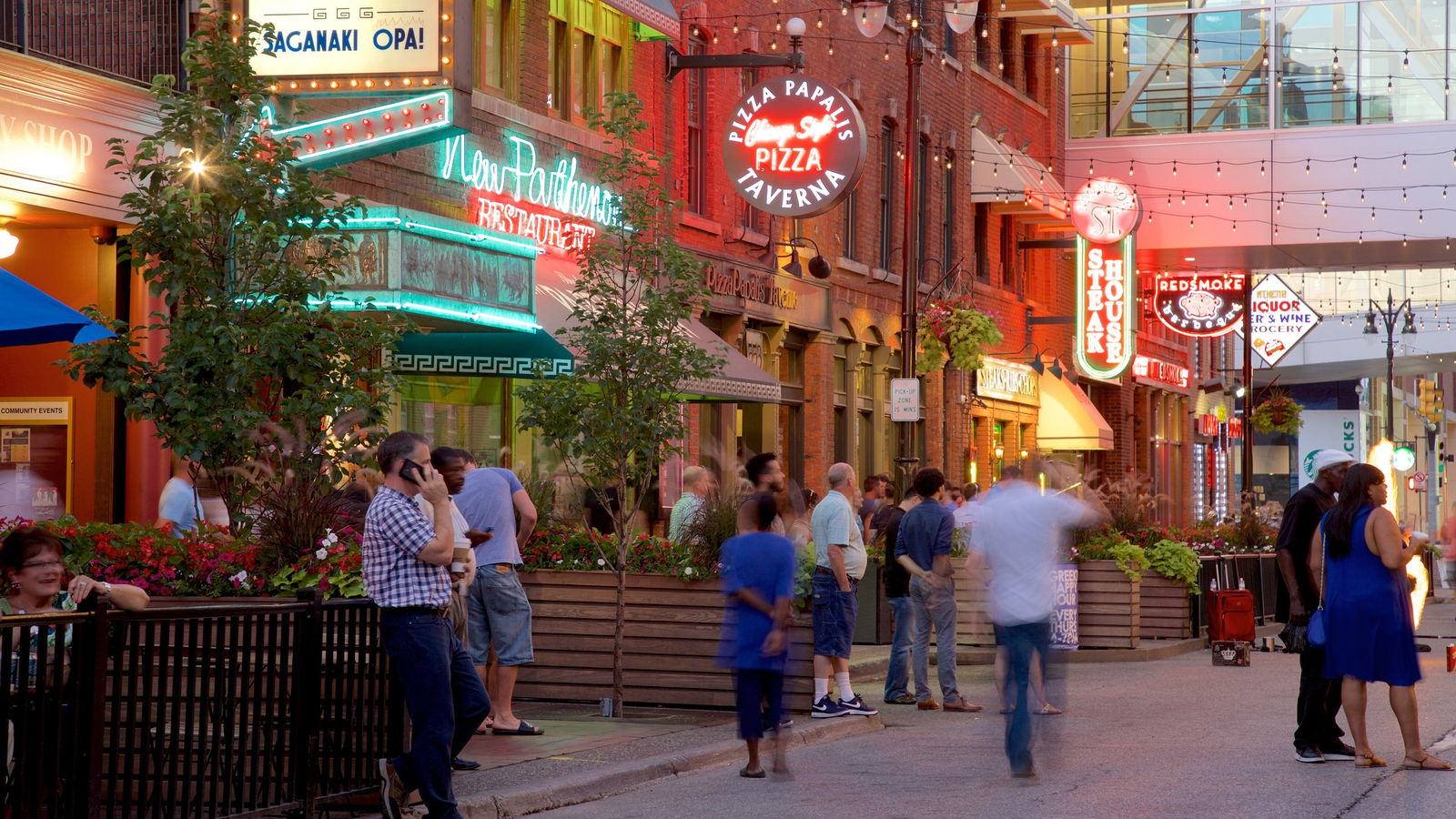Best 12 Free & Fun Things To Do in Detroit
Visitors may still experience Detroit’s vibrant history and culture scene without breaking the bank as the Motor City undergoes an economic and cultural comeback.
Beyond the recently revitalized center, the city’s varied neighborhoods provide a wealth of sights and activities that are ideal for budget-conscious tourists. Enjoy your next budget vacation by taking advantage of these top free activities in Detroit.
Best 12 Free & Fun Things To Do in Detroit (2025)
Watch the articulated BEHEMOTH at the DIA
Name and Location: The Detroit Institute of Arts is located at 5200 Woodward Ave, Detroit, MI 48202 in Midtown.
History and Significance: Founded in 1885, the DIA houses one of America’s most significant art collections. In the central Woodward Ave. entrance, kinetic sculptor Arthur Ganson’s whimsical metal machine “BEHEMOTH” enthralls guests.
What to Expect: Museum visitors gaze up at the oversized contraption made of metal, wood and rope as it endlessly cycles through chaotic-yet-graceful motions evoking the complexity of existence.
Visitor Information: Viewing BEHEMOTH is included with museum admission (free to residents). Public hours: Wed-Sun 9 AM–4 PM. Closed Mondays and Tuesdays.
This whimsical sculpture, one of the almost 70,000 artifacts housed within the galleries of the Detroit Institute of Arts, makes both children and adults grin. The vivid red BEHEMOTH, which faces Woodward in the Albert and Peggy de Salle Gallery of Modern Art at the DIA, was designed by Mark di Suvero in 1999 and is 45 feet tall. This enormous mobile creature is worth watching in motion since it is made of industrial I-beams that have been expertly linked together off-balance. However, since 2012, residents of Wayne, Oakland, and Macomb counties have been able to view the artwork and the rest of the museum for free because to a municipal tax subsidy. There will be admission fees for visitors from out of town.
See the Grounds at Nichols Arboretum
Name and Location: Nichols Arboretum encompasses 123 acres on the University of Michigan at 1610 Washington Heights, Ann Arbor, MI.
History and Significance: Originally farmfields, the land became a university botanical garden in 1906 renowned for Asian collections around the Peony Garden historic home. Its romantic landscape inspires rejuvenation.
What to Expect: Visitors stroll curving pathways to discover native woodlands, streams, lawns, floral collections and ruins evoking old-world architecture nestled across rolling topography.
Visitor Information: The arboretum grounds are open daily 7 AM–dusk. Peony Garden House offers tours June–August. Also visitor center and gift shop on site.
Take a leisurely walk through the University of Michigan’s regional outpost arboretum to see why it is considered one of the first “Public Ivies.” The Nichols Arboretum and Matthaei Botanical Gardens are located in nearby Nichols, just a short drive from Ann Arbor. Together, they feature more than 700 acres of formal gardens, vast lawns, wooded paths, and riverfront access that is open all year round. Winter sledding, spring wildflowers, an autumn corn maze, and breathtaking fall foliage among a variety of trees and shrubs from throughout the world are some of the seasonal highlights. This is a fantastic low-cost choice for tourists who enjoy open spaces because it offers free parking and entry.
Watch the Sunset over the Ambassador Bridge
Name and Location: The Ambassador Bridge linking Detroit and Windsor stands just west of downtown Detroit over the Detroit River.
History and Significance: Built in 1929, the Ambassador Bridge was once the world’s longest suspension bridge. Silhouetted against colorful sunsets viewed from Riverfront parks, its towers have become an iconic city skyline marker.
What to Expect: Locals and visitors gather along riverfront promenades with perfect views west through the neon-lit bridge overhead as the sun sinks behind it into the Detroit River’s horizon.
Visitor Information: Parks near Hart Plaza provide ideal public sunset viewing spots. Maximize skyline perspectives from Windsor’s riverfront. Golden hour lasts roughly 7:30 PM in summer.
For unhindered views of the Windsor, Ontario skyline with the famous suspension bridge in the foreground, locate a premium location along Detroit’s riverside. The 3.5-mile route from Hart Plaza to Gabriel Richard Park, which follows the Detroit River, is dotted with viewing spots. As the sky becomes pink, take a seat on the tiers of steps that descend to the promenade outside GM Renaissance Center. Or travel further east downriver, close to William G. Milliken State Park, to observe, during the long summer twilight, the passage of enormous freight liners alongside little pleasure boats departing for an evening cruise.
Explore Outdoor Murals
Name and Location: Vibrant murals and street art abounds across Detroit, particularly downtown and in neighborhoods like Eastern Market.
History and Significance: From Diego Rivera’s iconic murals to contemporary artists, Detroit’s creative spirit shines through in sanctioned public art installations and rebellious graffiti beautifying walls citywide. New works appear regularly.
What to Expect: Among endless examples, must-sees include the alleyway Belt art, the Boblo boats mural commemorating the old ferries, and the towers of Eastern Market. Snap some creative photos.
Visitor Information: Detroit’s exterior art galleries are free, publicly accessible year-round. Guided mural tours like those from Detroit Experience Factory dish all the details.
Public mural initiatives have exploded in recent years, bringing artistic expression to Detroit’s building facades. Thanks to yearly events that invite street artists to transform sometimes disregarded urban areas, downtown’s alleyways burst with color. Before they are painted over each season, everyone is able to look up at these temporary pieces of art for free. Next to Romain Blanquart’s piled truck artwork at Gratiot Central Market, the nine-story tall belt at 1600 Winder boasts elaborate 3D typography proclaiming the district’s name. Don’t forget to take in the striking dignity and direct look of Brenda “Safiya” Miller’s enormous image, which can be seen as you drive west close to New Center.
Celebrate Cultural Festivals
Name and Location: Festivals span various Detroit parks and venues, largely downtown along the Riverwalk and in neighborhoods like Mexicantown.
History and Significance: Cultural festivals give visitors a fun glimpse into Detroit’s diversity. Long-running ethnic celebrations fuse old traditions with contemporary music, food vendors, parades and local crafts.
What to Expect: Crowd-pleasers include the St. Patrick’s Parade through Corktown, Cinco de Mayo in Mexicantown, African World Festival at Hart Plaza, and music blowouts like Movement electronic fest.
Visitor Information: Detroit festivals occur spring through fall. Most run Friday-Sunday with free admission, except ticketed concerts. Event schedule and details on websites like Visit Detroit’s.
Every year, from spring to fall, a full calendar of events takes place throughout metro Detroit’s parks and public areas. During cherished yearly customs, locals and tourists unite to celebrate cultural history, individuality, and a sense of community. Highlights include the largest Cinco de Mayo celebration in the country at Patton Park, the Detroit Greek Independence Day Parade, which takes over Greektown with food and fashion, the Caribbean Carnival in Detroit, which features beautiful dancers, and the AsiaTown Street Fair, which lights up the sky over the Detroit River with 800,000 lanterns.
Take a Campus Tour
Name and Location: The University of Michigan provides tours from its Visitor Center at 3010 Student Activities Building, 515 E. Jefferson St. in Ann Arbor.
History and Significance: Founded in 1817 before Michigan statehood, U-M’s historic campus contains one of America’s great public university settings across central and north campuses. Exploring the Diag and Law Quad transports visitors back in time.
What to Expect: Free 90-minute walking tours by student leaders hit highlights like Burton Memorial Tower, the Michigan Union, Angell Hall Observatory and the renowned Michigan Stadium “Big House.”
Visitor Information: Public tours offered weekdays year-round when school is in session. Reservations required 24 hours in advance either online or by phone through Visitor Center.
Metro Detroit, which is home to 27 schools and universities, has a wealth of continuing education voucher choices. By viewing some of these campuses, which are conveniently located around the metropolitan area, visitors may take in breathtaking architecture, public art works, historic structures, and verdant green spaces. Admirers of architecture won’t want to miss classics like the magnificent Burton Memorial Tower on the University of Michigan’s Law Quad or the Art Deco structures designed by Albert Kahn and Eliel Saarinen at Wayne State in Midtown. On campuses like the University of Michigan Dearborn and Grosse Pointes University Liggett School, families can take self-guided walks or take advantage of free tours that are offered during school vacations.
Tour the Detroit Public Library
Name and Location: The Detroit Public Library is located at 5201 Woodward Ave, Detroit, MI 48202 in Midtown.
History and Significance: Founded in 1865, Detroit Public Library’s Main Branch has occupied its current home, designed by famed architect Cass Gilbert, since 1921. The building contains beautiful original architecture and artworks.
What to Expect: Visitors can explore the intricate interior and take free 1-hour public tours covering highlights like the granite foyer, murals, marble carvings and the ornate Burton Historical Collection room.
Visitor Information: Free guided tours run twice-monthly. Self-guided visits also welcomed during open hours. Main Branch hours: Monday–Thursday 9 AM–7 PM and Friday-Saturday 9 AM–5 PM.
The Main Branch of the Detroit Public Library became one of the city’s architectural treasures in 2019 after undergoing a roughly $3 million renovation. Beautiful Italian Renaissance details are paired with two sleek modernist additions, finished in 1963 and 1997, to the original cass gilbert structure from 1921. The building’s lofty Grand Hall and the comfortable Burton Historical Collection room are open to visitors at no cost. Or go to one of the many free, public art exhibits, book presentations, or community gatherings that are regularly offered on-site throughout the year.
See the Heidelberg Project
Name and Location: The Heidelberg Project is an open-air art installation spanning abandoned properties at 3600 block Heidelberg St. in Detroit.
History and Significance: Artist Tyree Guyton began the two-block found-object art environment in 1986 to revitalize his struggling neighborhood using reclaimed materials. It evolved into a world-renowned cultural destination.
What to Expect: Visitors view outdoor multi-media art displays made of salvaged items like doors, clocks, toys and textiles transformed into colorful symbols of hope along Heidelberg Street.
Visitor Information: The Heidelberg Project is free to view and open 24/7 year-round as an outdoor public art space. Guided tours available via booking.
On the east side of the city, this “open-air art environment” extends along Heidelberg Street and the surrounding area. In 1986, Tyree Guyton, a local artist, started putting up sculptures made of salvaged objects and brightly painted buildings with dancing dots all over his dilapidated block. Currently spanning two blocks and several city lots, self-guided tours allow visitors to view a constantly changing gallery that emphasizes topics related to race, class, culture, and the environment. Anyone who closely examines this interactive community art installation will be rewarded with abstract patterns, secret meanings, and some humorous touches.
Explore Southwest Detroit
Name and Location: Southwest Detroit refers to neighborhoods below Michigan Ave. like Springwells Village, Vernor Junction and Mexicantown.
History and Significance: Settled first by German, then Mexican immigrants, today Southwest Detroit remains the heart of Latino culture in Michigan, renowned for murals, shops and eateries.
What to Expect: Visitors stroll vibrant commercial corridors like Vernor Hwy. and Bagley St., view street art, and sample Mexican bakeries, restaurants, bars and stores carrying handicrafts and more.
Visitor Information: Southwest Detroit’s business districts are largely open daily. Check individual sites for hours. Guided tours available via companies like Detroit Experience Factory.
Explore areas outside of downtown to take in the sights, sounds, and flavors of some of the most active immigrant groups in the city. A business sector with taquerias, panaderias, carnicerias, and other genuine businesses is anchored by Mexicantown’s famous “Welcome to Mexicantown” gate. Inside Al-Haramain International Foods, around the corner, customers enjoy thick Middle Eastern coffee before perusing the spice shops at the neighboring Honey Bee Market. Don’t miss the beautiful tilework surrounding Our Lady of Guadalupe Church, Detroit’s oldest Catholic place of worship, or the music that fills Clark Park.
See the Guardian Building
Name and Location: The Guardian Building stands at 500 Griswold St. in Detroit’s Financial District.
History and Significance: The 40-story Art Deco skyscraper finished in 1929 boasts a vibrant exterior and grand four-story lobby, exemplifying 1920s urban grandeur. Its cathedral-like arcade earned it the “Cathedral of Finance” moniker.
What to Expect: Visitors crane their necks admiring the Turquoise Guardian roofline then step inside to discover an intricate beamed ceiling, Native American motifs, marble and displays highlighting this National Historic Landmark.
Visitor Information: The Guardian Building lobby accessed weekdays offers the free self-guided experience. Extended evening/weekend hours possible at certain downtown events.
Visitors are mesmerized by this Art Deco gem’s foyer, which is covered in shimmering tiles adorned with geometric patterns in gold and silver. The 500,000-square-foot office complex, known as the Cathedral of Finance, is flooded with natural light from its outside iconic clock and vaulted five-story atrium. Despite being privately owned, the Guardian Building’s stores and restaurants are open to the public during regular business hours. To enjoy the splendor of the building without disturbing office occupants, schedule your visit around lunchtime.
Tour Historic Sites in Greektown
Name and Location: Detroit’s Greektown lies just northeast of downtown, centered on Monroe Street between Brush and St. Antoine Streets.
History and Significance: Detroit’s Greektown emerged as hub for Greek immigration in the early 1900s. Historic commercial buildings house restaurants and businesses that retain Mediterranean heritage while also blending diverse cultures.
What to Expect: Foodies indulge in saganaki, gyros, paella and more before exploring sites like St. Mary Roman Catholic Church, the nation’s oldest Greek Orthodox Church, or the landmark Greektown Casino Hotel.
Visitor Information: Historic Greektown sites are largely open daily to visitors. Guided walking tours like those offered by Preservation Detroit provide deeper insights.
In downtown’s Greektown entertainment district, rebuilt buildings lining Monroe Avenue showcase Detroit’s rich early immigrant past. The Hellenic Museum, located inside the Nahas Grocery Building from 1845, is home to Michigan’s oldest antebellum building still standing. Or look up at the 1915 Sts. Constantine and Helen Greek Orthodox Cathedral’s adorned yellow brick exterior before entering to get a look at the elaborately decorated interior. Free parking makes it simple for guests to move between these locations, as well as the 1910 AHEPA Apartments and neighboring eateries that provide gyros, baklava, spanakopita, and flaming saganaki cheese.

